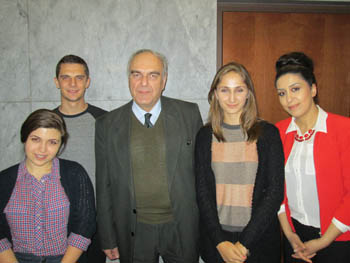TATEVIK HOVHANNISYAN – Staff Writer

Photo: Vartush Mesropyan.
An important facet of the history of the Armenians includes their fascinating activities in the Diaspora. To be able to prosper, invent, and progress outside the boundaries of ones nation shows the true diligence of the Armenian people.
The work of Armenian artists from the Crimea and Romania was the focus of a lecture on Wednesday, February 12, presented by Dr. Levon Chookaszian, UNESCO Professor of Armenian Art History at Yerevan State University, and one of the leading authorities in the world on Armenian art.
Dr. Chookaszian’s lecture, entitled “The Armenians of the Crimea and Romania as Seen Through Their Art,” was organized by the Armenian Studies Program as part of its Spring Lecture Series. The lecture was co-sponsored by the Virginia-based Ararat Foundation, which was founded in 1985 and promotes Armenian culture and Christian faith, through lectures on Armenian subjects, seminars, literature distribution and research.
The presence and impact of Armenians in Crimea and Romania is a unique subject, and it is indeed surprising to learn about the extensive influence of Armenians in the Diaspora.
“When dealing with the Armenian legacy of Crimea and Romania, we are dealing with the Diaspora of Armenian artworks,” stated Dr. Chookaszian. Armenians have established many communities and left their marks on the history and culture of foreign lands. The Armenian community in Crimea was established in the beginning of the 11th century, and Armenians brought with them their exceptional artworks and manuscripts.
Armenian art, such as manuscripts and architecture, was featured in the lecture. Dr. Chookaszian displayed images of the unique artworks and described their background and details. In particular, he shared his knowledge on the churches built in Kaffa, currently Theodosia: St. Sargis, St. Gevorg, St. Arakelots‘ and St. Hovhannes, all built in the 14th century. Many of the Armenian churches were built originally with wood, but after many of them burned, stone was used as the preferred material for construction.
Kaffa was one of the most important centers of Armenian culture, where Armenian communities existed until the 20th century. One of the most extraordinary and well-known natives of Kaffa was the note seascape painter Hovhannes Ayvazovski. Another city of focus was Surkhat, possible a corrupted version of the word Surb Khach (Holy Cross).
Dr. Chookaszian explained how manuscripts were transported from Cilicia, including works such as the Gospel of 1260 by Toros Roslin, the Gospel of Eight Miniaturists, the Gospel of Smbat the Constable (13-14th century), and the Bologna Bible.
The city of Gherla, located in close proximity to Hungary, was established by the Armenians 300 years ago. Designed, planned, and built like a genuine Armenian city, the buildings in Gherla shared strong similarities with those in Armenia. With only 200 Armenians living in Gherla, today most consider themselves Hungarians, with Armenian origins, and are unable to speak the Armenian language. However, a wonderful tradition exists in the region that has been preserved throughout time. Every year, on the name day of St. Gregory the Illuminator, the Armenian people who once lived in Gherla, scattered around the world, return to Gherla and celebrate their history.
The amazing history of Armenians in the Crimea and Romania is little known, which is why this was such a wonderful experience for the audience. The amount of architecture and art that Armenians have developed in the Crimea shows how wherever an Armenian goes, their talents, skills, and values follow.
“I never knew that Armenians had moved to Eastern Europe and established so many cultural centers in the Middle Ages. It was interesting to learn that some of the architectural structures are still standing,” commented fine-arts student Margaret Srmayan.
Many agreed that one of the highlights of the evening was seeing the reproductions of illuminated manuscripts on display, brought by Dr. Chookaszian. The audience was able to see first-hand the intricate details and meticulous work in each piece of art.
 Hye Sharzhoom Armenian Action
Hye Sharzhoom Armenian Action